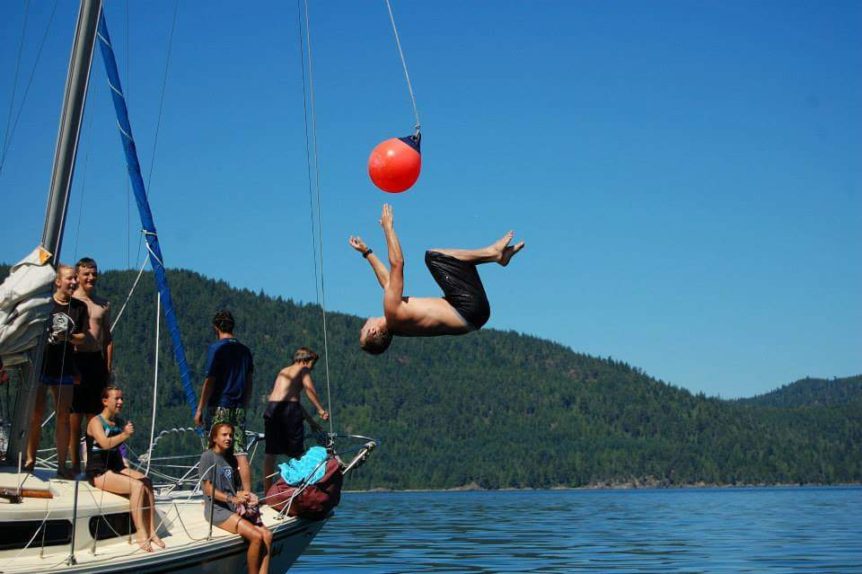More often than we like, a perfectly good sailing day is cut short by a serious die off in the the wind. What do you do now? Many resources would point to various activities or chore lists. Clean the boat, make lunch and wait it out, or go back to port and wait for a better day to sail. are obvious choices. These are all completely fine and most of the time are very necessary tasks to complete. A windless day is the perfect time for this.
For those who don’t really like these options, or who are on a multi-day trip, or for those who have done all the above already and it’s time for a change, this article is for you! I want to explore some creative, fun, and safe ways of having fun on a no wind day aboard a sailboat, that I personally have done. I know, I know, sailboats are plenty of fun, exactly they way they are designed. But what can you do if you’ve got rambunctious kids or teens aboard and the wind just died? When the wind ceases, motoring for hours, relaxing and taking in the afternoon air and sun lasts for about 6 minutes, then kids start getting into stuff. Grrrr.
This guide is about uncommon but seriously fun ideas for becalmed (no wind) days that are safe for your boat, fun for the young and the young at heart, make great memories and even more spectacular pictures. In this guide I will explain how to:
- Drag a fender and go swimming
- Raft up with other boats
- Keel Surf
- Boom Swing
- Mast Swing
Drag a Fender and Go For A Swim
This one is easy. Take the stern line that is likely sitting obediently on your stern cleat, and attach a longer line and fender or buoy to the end of it. You will likely need a long trailing line, something in the ballpark of 50 ft at least. Power up the motor and move ahead at about 4 knots. At speed, toss the line and fender into the water. Adventure seekers can jump in the water, grab hold of the line and get dragged a while. If you go fast enough, they can practice deep diving.
Deep diving is done by bending the body into an “L” shape. The principles of hydrodynamics will pull them way below the surface. Relaxing the body allows the life jacket’s buoyancy to take over, popping the swimmer to the surface. And that brings me to safety.
Safety is of course of the utmost importance in any of these activities. Swimmers should wear a properly fitted lifejacket. They should also jump into the water from the beam of the boat to ensure that they are well clear of the prop.
If no one is really into swimming, or weather conditions are not conducive to swimming, you can have adventure seekers ride around in the tender that you’re towing, while underway. Kids have a great time hauling themselves closer to the sailboat with the stern line, then letting it all out at once. They pretend all kinds of things when they’re in the tender and often make up little games and challenges to pass the time. Teens appreciate the change of scenery, however small it is. They also get a chance to talk without you around listening in. And I guess vice versa for the grown ups.
Rafting with other boats

This one is a bit trickier. Most articles on rafting usually have to do with a “mother ship” at anchor, while others approach and raft to this vessel. While this is a great way to enjoy boating culture with other enthusiasts, rafting under power is a great deal more involved, and a great deal more fun.
If you are travelling with other similar sailboats, consider rafting while under motor power. The conditions need to be ideal for this to work, but the more calm and boring the wind and seas, the better conditions there are for rafting with other boats. Here’s how it’s done:
- First make sure that sails are down and stowed. They probably are already, you weren’t sailing in these doldrums anyway. Next set out two or three fenders on the side of your sailboat that the other boat will be rafting on.
- From here, make sure you have a bow line and a stern line ready to go. When the two boats are close enough, pass the sternline and the bow line to the other boat by way of the beam. Do not throw the lines to the other boat. Thrown lines mean tangled lines almost all of the time. Also, if you drop a line while under way, you may foul the prop.
- The crew on the other boat will pass the bow line and stern line through the respective bow or stern cleats on their own sailboat, and pass the ends of the lines back to you. Cleat these lines off once the boats are in contact, properly aligned in parallel. Ensure that there are ample fenders at the beam to protect the gel coat before you tighten up on the lines!
With boats in parallel and rafting, crews can move from boat to boat enjoying each other’s spaces, sharing stories and snacks, playing games and getting really great pictures. You will only need one skipper at the helm for this, which means that the other skippers can get a reprieve from the tiller or wheel.
Caution:
If you attempt rafting while in motion, it is critical to have the bow secured and cleated off entirely. Do this before doing the same with the stern. When it is time to give the order to separate, make sure that the sterns are untied first. When the sterns are free, proceed untying and releasing the bows. If the stern is secured and there is a problem with the bow line, the accidental release of the bow will cause the boats to divert wildly and suddenly. With the sterns tied together and the bows moving apart, something will have to give. Old or worn stern lines will certainly snap like the crack of a whip as the bows separate. If you have good quality stern lines, the cleats will likely bust right out. Exceptionally rigid cleats and strong stern lines means something else may break or crack. Like most things regarding boating, mistakes are rarely cheap.
On calm, still waters, rafting is usually fairly uneventful for the helmsman. Occasionally there will be waves that are sizable enough to rock the sailboats. You can deal with this in two ways:
Turning into the waves
If a power boat should pass at speed, it will obviously trail a wake. Waves like this cause sailboats to rock and sway. When rafting with other sailboats, this could cause considerable damage if not properly mitigated. Your main concerns are the masts, spreaders, and the shrouds crossing into each other. They will collide as the boat hulls roll and pitch over the waves. By turning towards oncoming waves at 90 degrees, you almost entirely eliminate the hull roll action of those waves.
Offsetting the spreaders
When first initiating the rafting process, take special note of the relative position of the two boats. If you are careful to intentionally position one boat a few feet ahead of the other, then there is really no risk of the standing rigging clashing. It is still recommended that you turn into any oncoming waves and take them head on. If a wave or two sneaks up on you, or you have a sleepy helmsman who isn’t keeping a watchful eye, offsetting the spreaders will be an invaluable precaution that you have taken.
Keel Surfing
This is actually something I’ve done often and is certainly under the banner of “Uncommon Sailboat Fun”
This is also something that can really only be done while rafting with other boats underway. Don’t try this on the rafted boat that us under motor power. While rafting, one boat can supply the motor power for the rafted boats, leaving one or two other boats in tow, which is much more suitable for keel surfing.
Keel surfing is just what it sounds like: literally getting yourself under the boat and standing on the forward edge of the keel, while underway. Yes I said under the boat. This is also a great picture to capture if you have an underwater camera.
What you need for keel surfing is the bow line in hand, a set of swimming goggles, and a lungs full of air.
- First jump into the water from the deck of the sailboat with the bow line in hand. It’s best to jump in, or lower yourself in, as close to the bow as possible. Hanging onto the bow line, you will drag near the surface as you take your preparation breaths. When you’re ready, skim along on the water on your back with your belly towards the sky, and reach the hand closest to the boat way under as far as you can reach. I always feel for the bottom seam of the hull. That is my marker as I work aft towards the keel.
- Extended your arm as far under the boat as possible, grip the bottom of the boat and pull yourself below the surface. In one motion you can pull yourself towards the seam and replace your reaching hand with your chest and abdomen. From a distance, it would look as though you are hugging the boat from underneath.
- From this point, start working your way towards the keel, feeling with your feet as you go. Remember that bow line you were holding? It is in the hand furthest from the keel, and is now your way back out from the bottom of the boat. When you get to the keel, do whatever you want. It’s kind of a neat accomplishment to say you’ve sailed under a sailboat. You can put both feet on the forward edge of the keel and try to release all other contact with the boat. That’s a fun one. You can also keep working your way aft and hold the keel with both hands, letting your body drag back towards the stern. In pics it looks like the inverse of those orca whale trainers being dragged along by a dorsal fin at one of those those Aquarium shows.
When you’re out of air, you can use the bow line to pull yourself forward and out of the water. Because the motor is off and hopefully raised, you can also let go of the rope, push yourself deep, and let the boat glide overhead and pop up behind the boat in time to catch the dragging stern line.
Boom Swing
Be the boom king, and Set up a boom swing. What this means is you will be turning the boom into a side-to-side swing. This is not to be done while rafting! You will need to douse the main and cover it with the sail cover. Next, tie a short line from both ends of a long fender to the end of your boom. The fender itself will be the seat of the swing, so adjust the length of the ropes accordingly. You can also use a bosun chair for this, or a towel, which will also work just fine. The last thing you need to do is set your topping lift to support the end of the boom.
Have the first volunteer sit in the seat while the main sheet is still all the way in. The boom should be in line with the hull. Once they are ready, let out the main sheet almost all the way. The boom will be out at about 90 degrees out from the cockpit. If the swinger is heavy enough, their weight will certainly list the boat. They may even be able to drag their feet in the water. This is actually kinda fun and makes a great picture. Now for the fun, but much more risky step: swinging.
Everyone aboard needs to go to the opposite side of the boat from the swung out boom. The helmsman pulls on the main sheet to start the swing, then he gets low. Here comes the BOOM!
As the boom swings to the other side of the boat, the crew steps over to the other gunwale and acts as the counterweight to the boom swing. With some momentum and with the boat rocking almost rhythmically, the swinging action is not difficult to perpetuate.
Mast Swing
The mast swing is similar to the boom swing. It is best done with a buoy clipped onto one of the halyards. Raise the ball up to about waist height and secure the halyard to a cleat. Someone then sits on the ball like you would a rope swing. By pushing out and away from the boat, you can swing yourself well over the water before jumping in. Getting the boat rocking back and forth can add to the fun, but just be careful to not swing the person into the mast!
Conclusion
Windless days can be difficult to manage, especially for younger, more energetic sailors. It is imperative that you use your own judgement regarding safety. These activities may present safety risks you are not OK with. They also present opportunities for wear on the different components on your boat. Be sure to explain your rules regarding safety. Be detailed and direct. Explain what you (as the skipper) want and do not want to happen during these activities. I’ve passed many a dull wind day doing exactly the things written above, adhering to strict safety guidelines, and have always had great success. When cards, dice, and board games lose their charm, give one of these uncommon but fun ideas a try.

